The impact of rising coronavirus infections is back on the headlines with the number of cases rising in major European economies, affecting mobility. Platts also take a look at Russian gas flows into Europe, Southeast Asia’s appetite for Middle Easter crude, the surge in demand for Australian carbon credit units, and China’s soybean demand in the years ahead.
1. Recent surge in COVID-19 cases in Europe hits mobility
What’s happening? European mobility is declining on both seasonality and the recent rise of coronavirus cases. Despite the decline, mobility has held up better than in 2020. At this time last year, mobility had declined to only 75% of January 2020 pre-pandemic levels. Mobility correlates reasonably well with combined gasoline and diesel fuel demand in Europe, where diesel fuel accounts for 75% of the total, albeit on a declining trend.
What’s next? With COVID-19 cases rising throughout Europe, mobility is likely to continue falling, perhaps appreciably so. S&P Global Platts Analytics expects combined gasoline and diesel fuel demand to see a continuing decline into end-2021 and January 2022. Year-end transport fuel demand is likely to slip to 1.5%-2% below average 2019 levels, but still be up significantly from what was seen in 2020.
2. Uncertainty looms over Russian gas supply to Europe in December
What’s happening? No additional month-ahead pipeline capacity was booked to ship Russian gas to Europe on the two key transit routes via Ukraine and Belarus for December. Russian gas transit via Ukraine and Belarus has averaged only 88 million cu m/d and 19.3 mcm/d, respectively, or a combined 107.3 mcm/d so far in November.
What’s next? Russian flows will remain low, unless short-term capacity is booked in day-ahead and/or within-day auctions next month. The supply outlook is further complicated by a recent decision by the German energy regulator to suspend certification of the Nord Stream 2 pipeline that will carry Russian gas to Germany, meaning first flows on the new string are unlikely to start in the near term. There is little precedent for significant short-term day-ahead or within-day capacity bookings for Russian gas transit via Ukraine and Belarus, but they are likely to be necessary to allow Russian gas flows to rise to meet the seasonal increase in European gas demand in the absence of flows via Nord Stream 2. The market will therefore be watching the results of these daily auctions closely and any capacity bookings or lack of capacity bookings will have the potential to drive significant market volatility throughout December at European gas hubs.
3. Australia carbon credit prices hit record high
What’s happening? Carbon credit prices are going up on the back of positive sentiment following the UN Climate Change Conference, or COP26. Australia has seen a surge in demand for carbon credits, driving prices to record highs. Australia carbon credit units, or ACCUs, reached a record A$38.00/mtCO2e ($27.63/mtCO2e) Nov. 17. Prices have now climbed more than 95% from early July, growing alongside global demand for carbon credits since the second half of the year. Australia has been expanding the project types eligible for generating ACCUs, covering more and more new technologies and methods. The government has also put in place policies to simplify registration and trading practices to reduce market entry barriers. This attracts local farmers to supply ACCUs from reforestation, soil carbon sequestration and other methods.
What’s next? Demand for ACCUs is expected to increase significantly over the next decade. The Australian government is increasing the specialized fund for purchasing carbon credits while private companies under the compliance emission trading scheme are building up their ACCU portfolios and hedge future exposures. A growing number of corporates outside the compliance regime is also proposing voluntary emissions reduction targets and investing in ACCUs to meet their commitments.
4. China’s soybean demand forecast seen at record levels on booming swine herd
What’s happening? The market has been worried about China’s slackening soybean demand in recent months on the back of negative crush margins and sporadic cases of the African swine fever. China-based crushers have been struggling with negative margins amid high costs of raw soybeans and sliding soybean meal prices.
What’s next? Platts Analytics expects China’s robust pork industry consolidation to support soybean demand in the coming years, overshadowing the negative crush margin trend seen in 2021. According to Platts Analytics, China’s soybean demand in 2022 and 2023 are forecast at record levels of 102 million mt and 104 million mt, respectively.
5. Sweet, sour crude cargoes commanding lofty premiums in spot market
What’s happening? Southeast Asia’s state-run oil and refining companies typically secure around 70%-75% of crude oil requirements via term deals and their own upstream operations, while the rest is sourced from spot purchases. However, the refiners are looking for every possible means to reduce their spot procurement ratio recently as market premiums extend rally amid tight supply conditions.
What’s next? Thailand’s PTT Exploration and Production, or PTTEP, plans to bring home most of its equity crude barrels from its overseas upstream operations in 2022 rather than trading the oil, taking some pressure off domestic refinery feedstock procurement managers who constantly seek top-up barrels in the expensive spot market. PTTEP is set to provide domestic refineries at least 5 million barrels of Oman crude for delivery over January-June 2022. Apart from the equity Oman barrels, PTTEP also aims to supply domestic refineries its equity barrels from Algeria, Australia and the Americas.
Did you subscribe to our daily newsletter?
It’s Free! Click here to Subscribe!
Source: Platts































